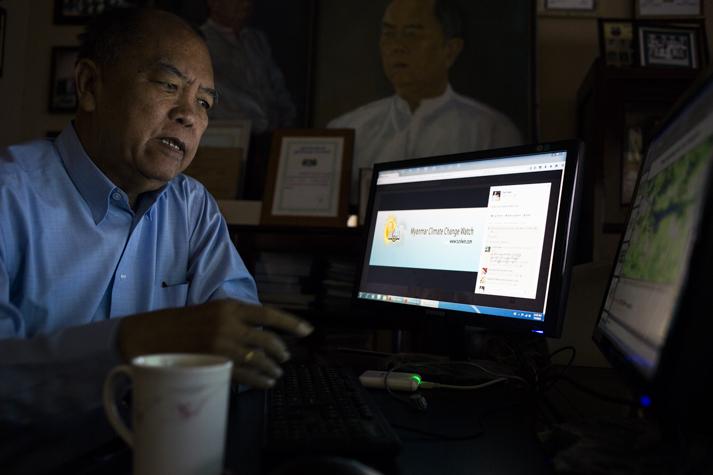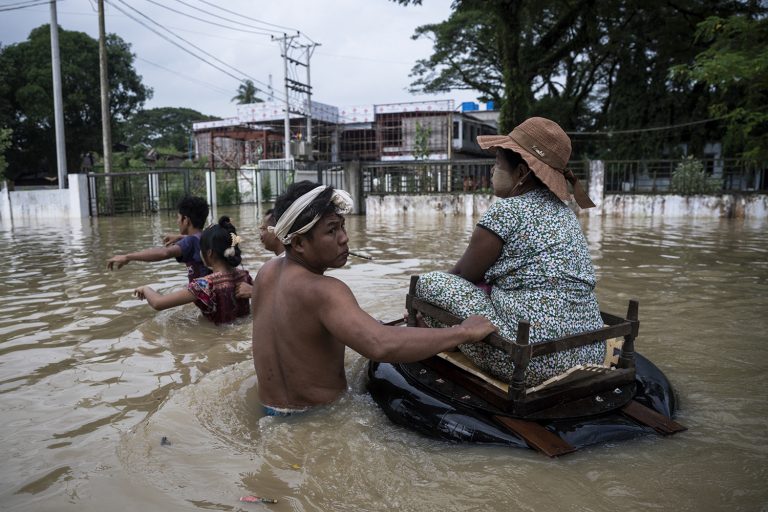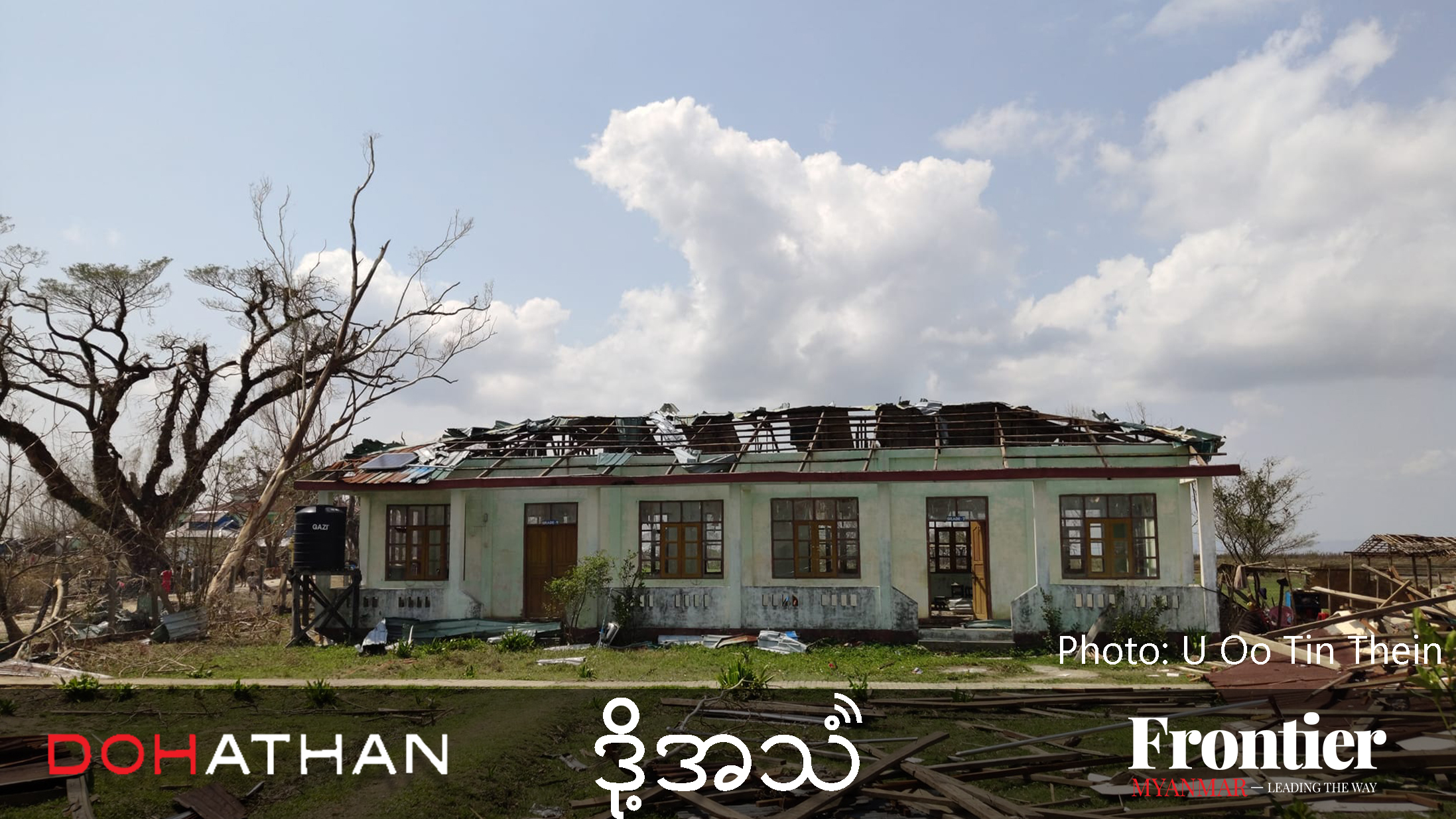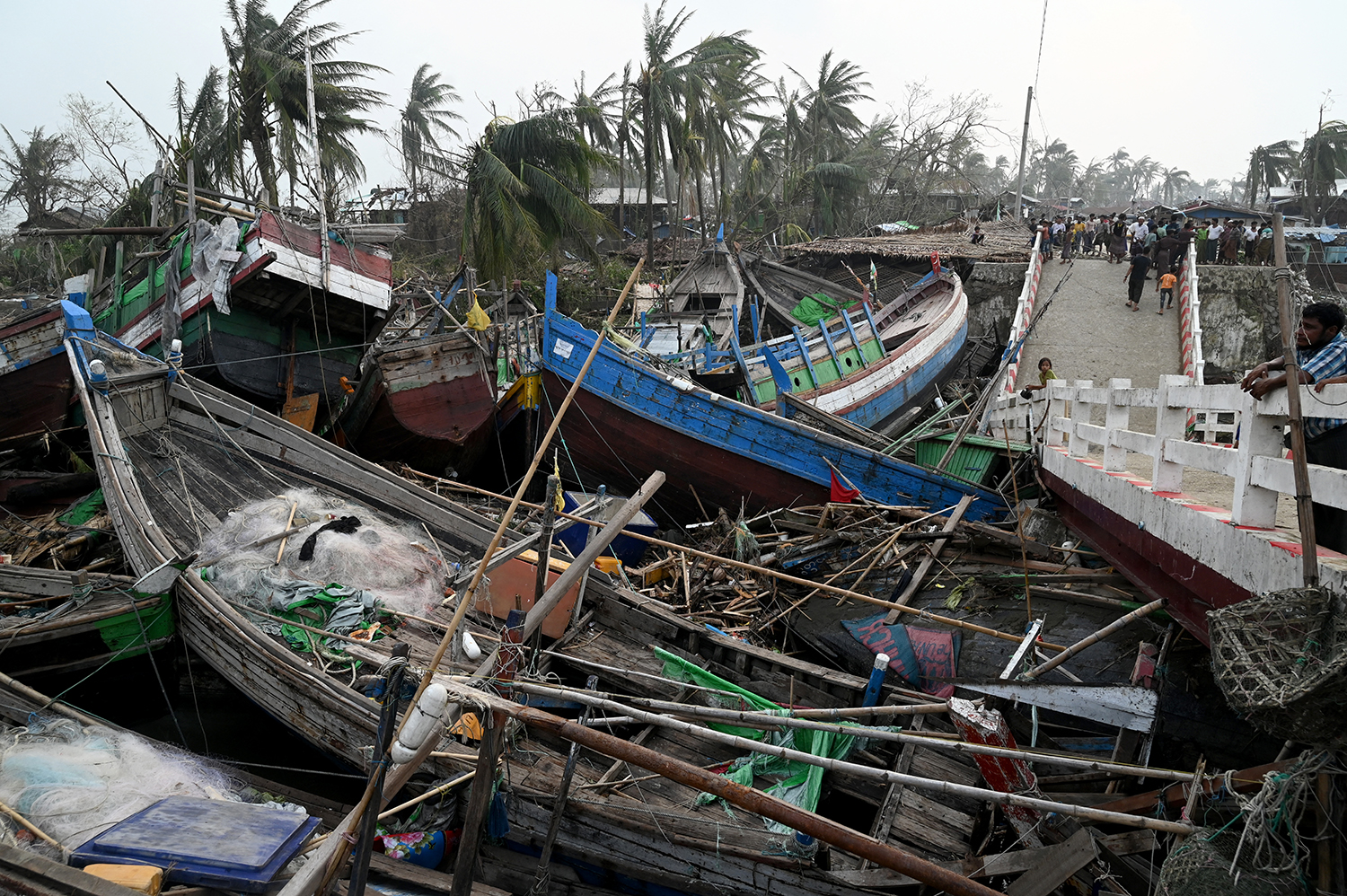Seven years ago, the landfall of Cyclone Nargis caused the worst natural disaster in Myanmar’s history. How prepared is the country if nature strikes again?
By ALEX BOOKBINDER | FRONTIER
U Tun Lwin spent 45 years with Myanmar’s Department of Meteorology and Hydrology, rising through the ranks to become director-general before retiring in 2009. During a career spanning more than four decades, one date stands out above all others: April 28, 2008.
That day, he and his team notified other government departments of an anomaly in the Bay of Bengal: a tropical cyclone, gaining intensity, headed – or so it appeared – towards Myanmar’s low-lying and populous Ayeyarwady Delta. U Tun Lwin knew Cyclone Nargis posed an imminent threat.
“I didn’t have the authority to evacuate people. I didn’t have the authority to give orders. That is some other department’s work. Unfortunately, they didn’t do anything,” he said. “I tried to work according to the [procedures] of the department. I called the head of state; I made an interview in the newspaper and called all the local authorities by phone. They knew everything in detail.”
Support more independent journalism like this. Sign up to be a Frontier member.
For the military junta, the timing was not fortuitous. The generals had scheduled a referendum on a new constitution for May 10 and were unwilling to allow freak weather to interrupt their plans.
Although the government ordered planes be sent from Yangon to Mandalay to avoid damage losses, it made no effort to evacuate people to safety or issue warnings to the public about the gravity of the impending storm. Five days later, Cyclone Nargis made landfall, affecting some 2.4 million people. About 140,000 people are believed to have perished in the cyclone and its aftermath.
The response from reclusive military government after the cyclone hit drew international condemnation. The junta spurned offers to accept a full scale international assistance effort and delayed the delivery of aid and the issuing of visas to foreign relief workers, decisions that contributed to a higher casualty toll.
“A lot of people say that the government was more concerned with the constitution referendum,” said U Tun Lwin. “That’s probably the main reason [for the government’s inaction],” he said. “In short, it wasn’t working. It was very poor management.”
Starting from scratch
The constitution was approved, paving the way for the transfer of power from the junta to nominally civilian political order in 2011.
Seven years after Nargis, Myanmar is a decidedly different place and the country has thrown open its doors to foreign investment. But some realities are not easily changed: according to the 2014 World Risk Report, published by the United Nations University’s Institute for Environment and Human Security, Myanmar is the 43rd most disaster-prone country in the world.
What makes Myanmar distinct, however, is the sheer variety of hazards it faces. Each year, the central dry zone succumbs to crippling drought, while low-lying coastal areas are disposed to extreme seasonal floods. Myanmar’s location in the global mid-latitudes and a long coastline make it susceptible to tropical storms of varying intensity, of which Nargis was the most extreme known example.
It’s not just the weather. The Sagaing Fault, which bisects central Myanmar’s most populated areas, leaves millions exposed to the hazards posed by earthquakes. “It’s the most vulnerable country in Southeast Asia. Different areas have different vulnerabilities,” said Angeliki Parasyraki, country manager for the Asian Disaster Preparedness Center (ADPC), a regional disaster risk reduction non-profit that works with the government to craft policy.
The government’s attitudes have shifted markedly since Nargis, said Ms Parasyraki. “They are very, very keen on organising, and to build the capacity of government officials to respond in times of disaster. They are very engaged in this process,” she said. “It [was] a realisation that [disaster risk reduction] is something that saves lives, that it is good for the nation.”
Since then, Nay Pyi Taw has backed four key documents on disaster mitigation and response. In January 2009, a government committee introduced a “standing order” that codifies divisions of labour and duties in times of crisis. Later that year, a consortium of five government agencies and four NGOs issued a comprehensive, region-by-region profile of natural hazards.
After three years of work, the Myanmar Action Plan on Disaster Risk Reduction (MAPDRR) was released in 2012 to serve as a guide for mitigation efforts to the end of 2015. In July 2013, the parliament passed the country’s first natural disaster management law. Increasing climate-related threats mean that these measures will likely be put to the test more often.
Germanwatch, a climate-focused think tank, has said Myanmar was affected by climate-related events – such as cyclones, droughts and floods – to a greater degree than any other country on earth except Honduras between 1994 and 2013 and that the frequency of these events is certain to increase.
Research by U Tun Lwin shows that Myanmar’s monsoon season has shrunk by an average of 40 days since 1978. “When you talk about onset, it is shortened by 15 days, and when you talk about withdrawal, it is 25 days earlier,” he says. “That has a huge impact on the country.”
A shorter monsoon means that Myanmar’s semi-arid central plains will become more susceptible to drought. It also means that Myanmar’s storm seasons – which bookend the monsoon – have been getting longer.
“In the past, Myanmar was threatened by a storm maybe every two or three years,” he said. “Now, [there’s a storm] almost every year.”
As the monsoon season continues to contract, tropical storms and cyclones will become more frequent, said U Tun Lwin. “You have two storm seasons, and they have both been extended, meaning you have a higher risk of more storms.”
Shaky foundations
In 1930, a magnitude 7.3 earthquake – and an accompanying tsunami – ravaged Yangon and nearby Bago, killing more than 500 people. At the time, fewer than half a million people lived in Myanmar’s largest city.
Almost all of central Myanmar’s major population centres are near the Sagaing Fault, which runs through the middle of the country, from the far north to the Gulf of Martaban east of Yangon.
Today, Yangon’s population has grown tenfold. The Sagaing Fault continues to pose a threat – and future severe earthquakes will thus affect many more people than tremors just a few decades ago.
In recent years, Myanmar’s urban centres have been among the fastest growing in Asia, a process that will intensify as the country moves away from its agrarian past.
“Myanmar is going through a rapid urbanisation process after opening up. Cities are bound to grow,” said Bijay Karmacharya, the country program manager for UN-Habitat, a UN agency involved in drafting and implementing disaster risk reduction measures. “It’s very important to make cities resilient to future disaster, and the policy will incorporate those elements,” said Mr Karmacharya.
“There’s a proverb: earthquakes don’t kill people, but buildings do,” said U Soe Thura Tun, a geologist and member of the Myanmar Earthquake Committee, a group of scientists that has helped formulate policies to strengthen urban resilience.
In major cities, much of the housing stock was built without taking seismic realities into account. “The main thing is to make sure that buildings are resistant to earthquakes, according to appropriate conditions,” U Soe Thura Tun said.
To achieve that objective, the MEC and the Myanmar Engineering Society, with support from UN-Habitat, have drafted a new construction code that will replace existing rules to make buildings more resilient to seismic shocks.
The new code is yet to be passed into law by parliament. However, Mandalay, which was affected by an earthquake in November 2012 about 75 miles to its north that killed about 20 people and caused widespread damage, has already revised its entire urban development plan. The Yangon City Development Committee, the body responsible for urban development and planning in Yangon, is already starting to enforce the building code, too.
Enforcement, however, is likely to be a challenge.
“[Having] a building code is important, but the most important thing is if people read it or not,” said Wang Yu, a research fellow at the Earth Observatory of Singapore who is working with the MEC. “Look at the Nepal earthquake. Do they have a building code? Yes, they do. But do people really [follow] that building code? No, they don’t,” Dr Wang said.
Compliance will invariably mean greater costs for construction companies and the industry is rife with corruption. “Local businessmen, they aren’t [very] happy,” joked U Soe Thura Tun. “But this is for their sustainability.”
He says municipalities should employ third-party qualified engineers as building inspectors to assess construction quality but acknowledges that finding skilled personnel will be a challenge.
The MEC receives no government support and its efforts to establish seismic monitoring systems have been largely financed by external donors. “Let’s put it this way: the waiting list is long, and scientific research isn’t a priority,” said Dr Wang.
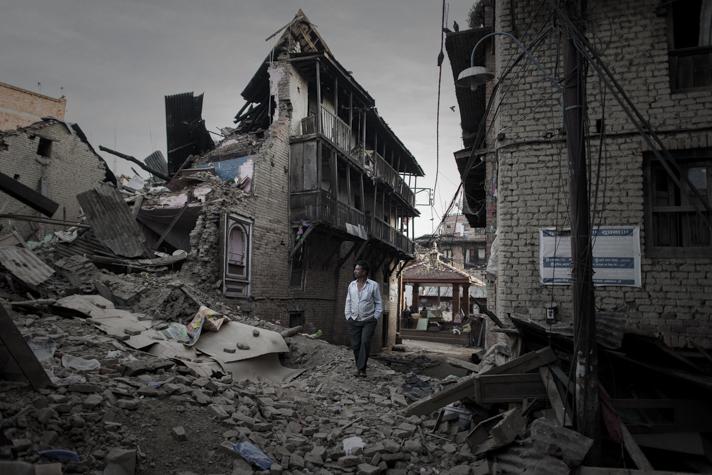
A pedestrian walks past destroyed houses in the village of Satungal on the outskirts of Kathmandu in May 2015. (Philippe Lopez / AFP)
Putting it to the test
In April, Mr Karmacharya from UN-Habitat was visiting his native Nepal when it was rocked by the earthquake that caused the country’s worst natural disaster in 80 years.
For better or for worse, the visit provided an opportunity to see how his own country’s disaster response mechanisms functioned at a time of crisis.
Mr Karmacharya said the government should have been stockpiling supplies for years but did not have adequate reserves to respond to the emergency.
“When I [learned] what was there in Nepal, I was disappointed,” he said. “In spite of all the contingency planning and knowledge and all that, they didn’t have things in stock.”
Although the disaster management mechanisms put in place in Myanmar since 2008 have not yet been put to a major test, Mr Karmacharya is confident that the government is developing proper stores of essential supplies in the event of a crisis.
He praised the working group implementing disaster risk reduction policies in Myanmar as being among the most functional coordinating body with which he has worked anywhere in the world.
The government has implemented township-level disaster management committees in risk-prone areas throughout the country, said Mr Karmacharya. Later this year, a government-backed disaster management training school is set to open in Ayeyarwady Region’s Hinthada Township, one of the areas that bore the brunt of Cyclone Nargis.
Mr Karmacharya said that despite the inability of the Nepalese government to respond quickly to the earthquake, he believed it had handled the crisis reasonably well, given the disruption to roads and communications systems.
“None of the countries like [Myanmar or Nepal] will be really fully geared and fully prepared. You’ll always have some structures and ideas in place, but there will be big chaos,” he said.
After Nargis, the junta actively prevented foreign aid from being brought into Myanmar. Aid bottlenecks in Nepal were due to bureaucratic disorganisation and shattered infrastructure, not wariness of foreign intentions.
In April, the Indian Army sent troops to Nepal to assist in the relief effort, with Kathmandu’s blessing. In 2008, by contrast, the junta refused repeated offers of emergency aid from the US, British and French navies, each of which had sent ships loaded with relief supplies they were not permitted to unload.
The logistics expertise of military organisations means that foreign armies often play a crucial role in relief operations. But whether Myanmar’s military – still the country’s most powerful institution – would allow foreign boots on the ground to save lives during future disasters is open to speculation.
Even if the military was to choose to limit future relief efforts, having comprehensive systems to mitigate disaster risk and respond to crises will be critical for saving lives.
“I think the country is on the right path,” Mr Karmacharya said. “But to make everything perfect will be a decade-and-decade long phenomenon. We will get there, but it will not be tomorrow.”


